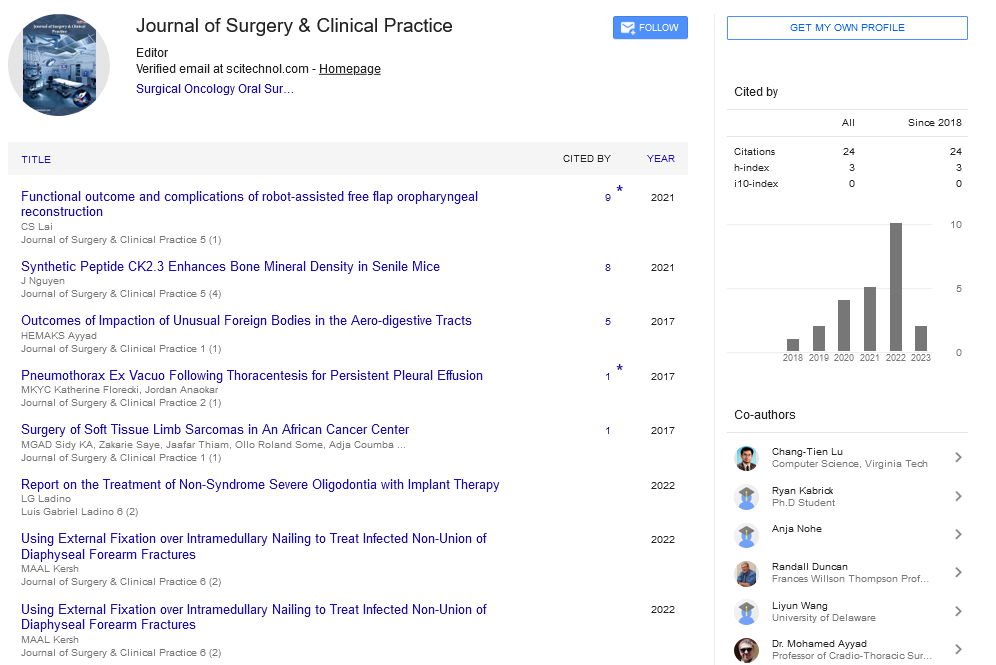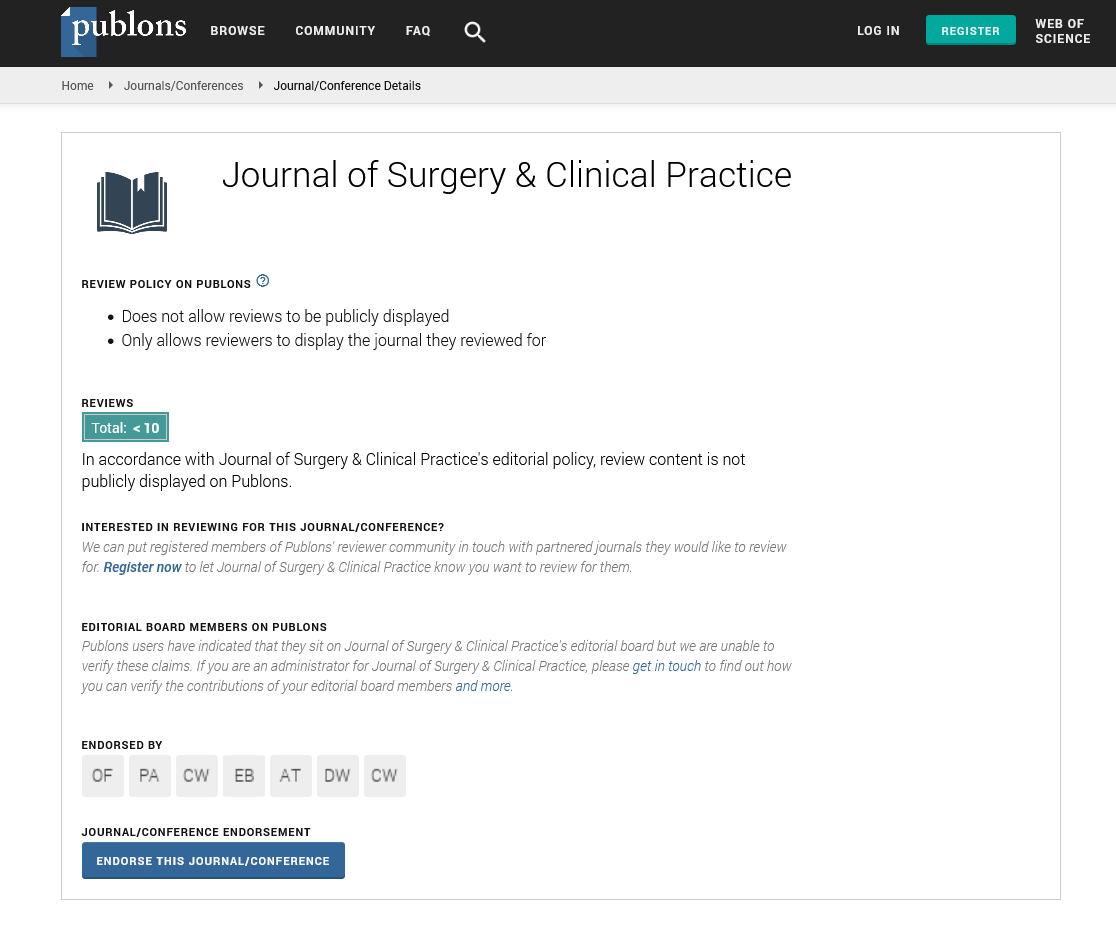Opinion Article, J Surg Clin Prac Vol: 7 Issue: 4
Tools and Techniques used in Endoscopic Gastrointestinal Surgery
Eiichi Hondo*
1Department of Medicine, University of the Pacific, California, USA
*Corresponding Author: Eiichi Hondo,
Department of Medicine, University of the
Pacific, California, USA
E-mail: elrich@hnd.edu
Received date: 22 November, 2023, Manuscript No. JSCP-23-120884;
Editor assigned date: 24 November, 2023, Pre QC No. JSCP-23-120884 (PQ);
Reviewed date: 08 December, 2023, QC No. JSCP-23-120884;
Revised date: 15 December, 2023, Manuscript No JSCP-23-120884 (R);
Published date: 22 December, 2023, DOI: 10.35248/ JSCP.23.7.100401.
Citation: Hondo E (2023) Tools and Techniques used in Endoscopic Gastrointestinal Surgery. J Surg Clin Prac 7:4.
Description
Endoscopic gastrointestinal surgery has emerged as a transformative field, revolutionizing the diagnosis and treatment of a myriad of gastrointestinal disorders. The cornerstone of endoscopic gastrointestinal surgery lies in the flexibility and maneuverability of the endoscope. These slender, fiber-optic instruments equipped with high-resolution cameras allow surgeons to visualize the interior of the digestive tract in real-time. The flexible endoscope can be navigated through various twists and turns, reaching deep within the gastrointestinal system with minimal invasiveness.
Capsule endoscopy represents a groundbreaking tool for exploring the small intestine. Patients swallow a small, pill-sized capsule containing a camera that captures thousands of images as it travels through the digestive tract. This non-invasive approach provides valuable insights into areas that were once challenging to reach with traditional endoscopes.
While flexible endoscopes dominate, rigid endoscopes play a crucial role in certain procedures, offering stability and precision in focused interventions. These instruments are particularly useful in accessing targeted areas with minimal tissue distortion, aiding in precise diagnosis and treatment. Endoscopic Mucosal Resection (EMR) is a technique used to remove abnormal or cancerous tissue from the gastrointestinal lining. Utilizing specialized endoscopic tools, surgeons lift the targeted tissue and cut it away, minimizing the need for more invasive surgical procedures. EMR has become a preferred method for addressing early-stage gastrointestinal cancers. Endoscopic Submucosal Dissection (ESD) takes the principles of EMR a step further by allowing for the en-bloc removal of larger lesions. This technique involves dissecting the submucosal layer, enabling the removal of tumors that would traditionally require more extensive surgeries.
ESD has revolutionized the approach to certain gastrointestinal tumors, providing a less invasive alternative. Endoscopic Retrograde Cholangiopancreatography (ERCP) combines endoscopy with fluoroscopy to diagnose and treat conditions affecting the bile ducts and pancreas. Through the endoscope, contrast dye is injected, allowing the visualization of the biliary and pancreatic ducts. ERCP is commonly employed to remove gallstones, place stents, and address other obstructive issues in these critical pathways.
Endoscopic placement of stents has become a standard intervention for addressing strictures or blockages within the gastrointestinal tract. These stents, often made of metal or biodegradable materials, provide structural support to keep the affected area open, promoting improved passage of fluids and nutrients. Advancements in endoscopic suturing techniques have expanded the scope of endoscopic surgery. Surgeons can now close perforations, manage leaks, or perform tissue approximation using specialized endoscopic suturing devices. This capability has broadened the range of conditions amenable to endoscopic intervention.
The evolution of tools and techniques in endoscopic gastrointestinal surgery has significantly impacted patient care. Minimally invasive procedures translate to reduced postoperative pain, shorter hospital stays, and quicker recovery times. Patients undergoing endoscopic surgery often experience improved quality of life and a faster return to normal activities compared to traditional surgical approaches. Moreover, the reduced invasiveness of endoscopic procedures minimizes the risk of complications, making them particularly appealing for patients with comorbidities or those who may not tolerate more extensive surgeries well. The ability to perform certain interventions on an outpatient basis further enhances the efficiency and cost-effectiveness of patient care.
While endoscopic gastrointestinal surgery has witnessed remarkable progress, challenges persist. The learning curve for mastering advanced endoscopic techniques is steep, requiring specialized training for surgeons. Additionally, the limitations of current endoscopic tools, such as restricted access to certain anatomical regions, continue to drive innovation in the field. The future of endoscopic gastrointestinal surgery holds promise for continued refinement and expansion of capabilities. Integration with robotics, artificial intelligence, and further miniaturization of instruments are likely to enhance precision and broaden the applicability of endoscopic interventions. As the field advances, addressing challenges and refining techniques will be essential for ensuring the ongoing success of endoscopic gastrointestinal surgery.
 Spanish
Spanish  Chinese
Chinese  Russian
Russian  German
German  French
French  Japanese
Japanese  Portuguese
Portuguese  Hindi
Hindi 
